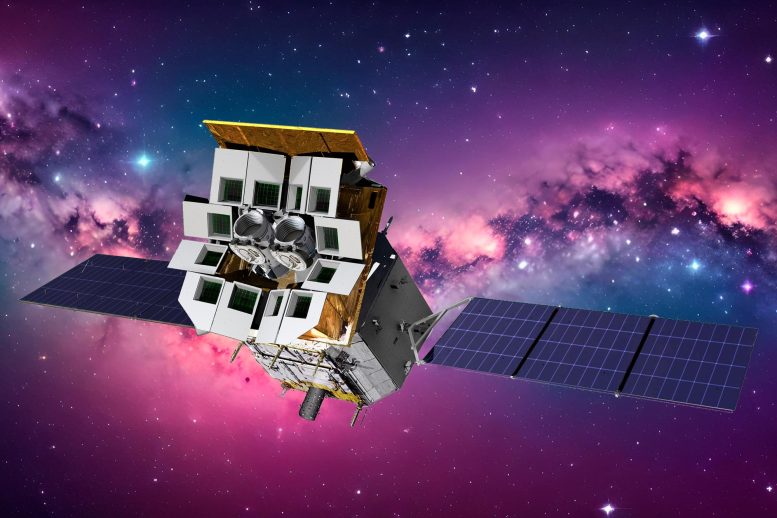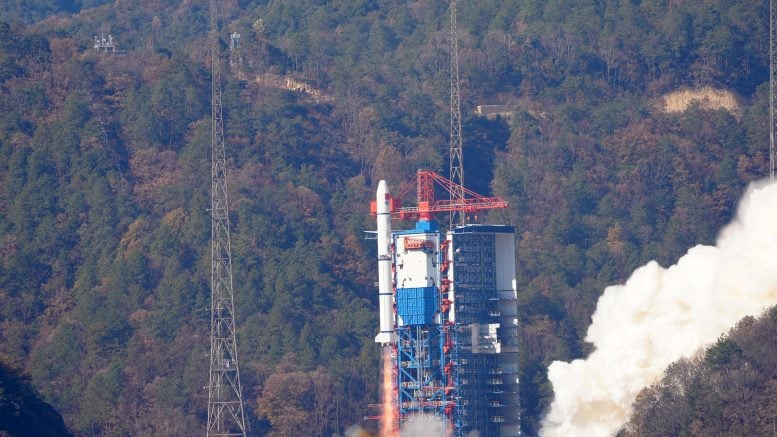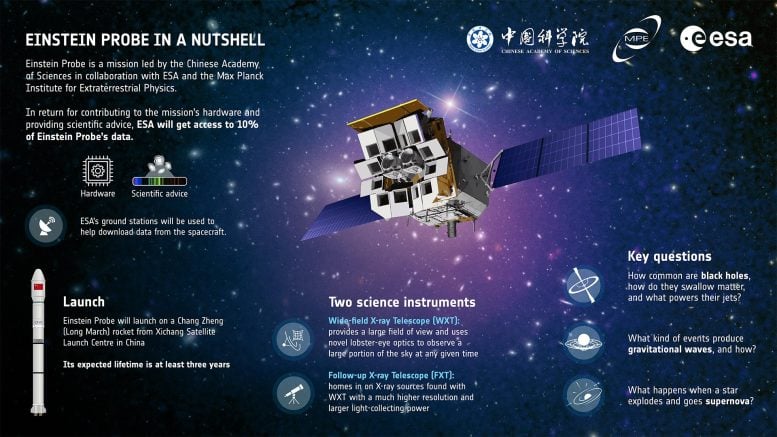
The Einstein Probe, launched on January 9, 2024, is a joint venture led by the Chinese Academy of Sciences, with contributions from ESA and MPE. Its goal is to study X-ray emissions from cosmic phenomena, enhancing our knowledge of the Universe and gravitational waves. Credit: Chinese Academy of Sciences
Launched successfully, the Einstein Probe aims to explore X-ray light from celestial phenomena and deepen our understanding of the Universe.
The Chinese Academy of Sciences (CAS) spacecraft Einstein Probe lifted off on a Chang Zheng (Long March) 2C rocket from the Xichang Satellite Launch Center in China at 15:03 CST / 07:03 GMT / 08:03 CET on January 9, 2024. With the successful launch, Einstein Probe began its mission to survey the sky and hunt for bursts of X-ray light from mysterious objects such as neutron stars and black holes.

On January 9, 2024, the Einstein Probe, a spacecraft developed by the Chinese Academy of Sciences in collaboration with the European Space Agency and the Max Planck Institute for Extraterrestrial Physics, successfully launched. Its mission is to survey the sky for X-ray light from objects like neutron stars and black holes. Credit: Chinese Academy of Sciences
International Collaboration
Einstein Probe is a collaboration led by CAS with the European Space Agency (ESA) and the Max Planck Institute for Extraterrestrial Physics (MPE), Germany.
“I would like to congratulate our colleagues at CAS on the successful launch of an innovative mission that is set to make great strides in the field of X-ray astronomy,” says Carole Mundell, ESA’s Director of Science. “At ESA, we value international collaboration to advance science and deepen our understanding of the cosmos. I wish the Einstein Probe team a very successful mission.”
Technical Capabilities
To efficiently monitor the entire sky and routinely discover new X-ray sources, Einstein Probe is equipped with two instruments that together deliver a wide and sensitive view of the celestial sphere: the Wide-field X-ray Telescope (WXT) and the Follow-up X-ray Telescope (FXT). The design of WXT’s optics is inspired by the eyes of lobsters; in a modular layout, it employs hundreds of thousands square fibers that channel light onto the detectors. This gives Einstein Probe the unique capability to observe nearly one tenth of the celestial sphere in a single glance. New X-ray sources spotted by WXT will be immediately targeted with FXT, which has a narrower view but is more sensitive and will capture more details.
ESA supported testing and calibrating of the X-ray detectors and the optics of WXT and developed the mirror assembly of one of FXT’s two telescopes in collaboration with MPE and Media Lario (Italy). MPE contributed the mirror assembly for the other telescope of FXT, as well as the detector modules for both FXT units. ESA also provided the system to deflect unwanted electrons away from the detectors (the electron diverter). Throughout the mission, ESA’s ground stations will be used to help download the data from the spacecraft.
In return for these contributions, ESA will get access to 10% of the data generated by Einstein Probe’s observations.

Einstein Probe will study the Universe in X-ray light. Equipped with a new generation of X-ray instruments with high sensitivity and a very wide view, this mission will survey the sky and hunt for powerful blasts of X-ray light coming from mysterious celestial objects such as neutron stars and black holes. Credit: ESA
Mission’s Significance
The ability of the mission to spot new X-ray sources and monitor how they change over time is fundamental to improving our grasp of the most energetic processes in the Universe. Powerful blasts of X-rays occur when neutron stars collide, supernovas explode, and matter is swallowed by black holes or ejected from the crushing magnetic fields that envelop them.
“I am looking forward to the discoveries that Einstein Probe will enable,” says Erik Kuulkers, ESA’s Einstein Probe Project Scientist. “Thanks to its uniquely wide gaze, we will be able to catch the X-ray light from collisions between neutron stars and find out what is causing some of the gravitational waves we detect on Earth. Often, when these elusive space-time ripples are registered, we cannot locate where they are coming from. By promptly spotting the burst of X-rays, we will pinpoint the origin of many gravitational wave events.”
Orbit and Operations
After launch, the Einstein Probe reached its orbit at an altitude of approximately 600 km. The spacecraft circles the Earth every 96 minutes with an orbital inclination of 29 degrees and it is able to monitor almost the full night sky in just three orbits.
In the next six months, the operation team will be engaged in testing and calibrating the instruments. After this preparation phase, Einstein Probe will spend at least three years attentively watching the entire X-ray sky.









Be the first to comment on "Einstein Probe Launches: A Paradigm Shift in X-Ray Astronomy"